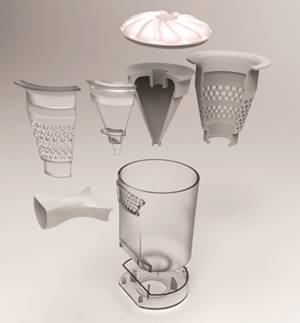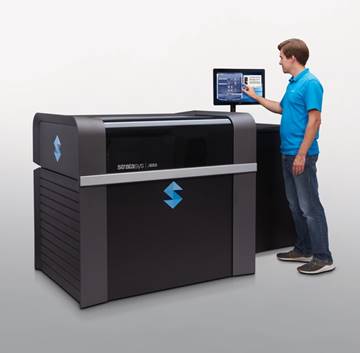Stratasys PolyJet systems have always had brilliant colors and been the tools of choice for many seeking prototypes. Now, with the Stratasys J850 Pro, the company is entering new territory by offering a J8 3D printer that’s affordable and doesn’t have color. This is kind of like if Ferrari went, “We have a new Ferrari: its $80,000 and doesn’t go faster than 80Km per hour.” Color has always been the defining characteristic and selling point of these printers, so this is a rather unexpected outcome of Stratasys segmentation strategy.

The Eden Prairie firm now has a J850 Prime, which has color, and this one. Then, there are the J700 for clear dental aligners, the J720 for color dental aligners and the J750 Digital Anatomy. You can just see the glint in the McKinsey guy’s eye as he pitches this. The printer profusion is confusing for customers. It’s also a bit paradoxical that Stratasys’s R&D and product development time is being spent in breaking the printer just right for every customer.
Essentially they’ve locked it for color and made it cheaper. Any value based price “inequalities” may make some customers unhappy. On the upside, a completely integrated, easy-to-use package for a particular segment will make it simpler to adopt it for production. Optimized systems and toolchains for one application will make training and operation easier, as well. From the point of view of Stratasys shareholders, this approach can get the company a lot of value and a lot more revenue. Unless, of course, people find out how to hack the cheaper versions to make them print full color.

The printer can jet seven materials at the same time and has the familiar 490 x 390 x 200mm build volume and standard materials, just no color capability. You can use the grayscale Vero materials: Vero Clear, Vero Ultraclear, Agilus, and Digital ABS. There’s a Super High Speed Mode that’s twice as fast as unspecified previous printers and at least there is a software upgrade path to the color version.
The company sees its usefulness in, “accurate simulation of textures, product labeling, shock absorption, fit and functional testing, over-molding, living hinges, injection molds, embedded sealing elements, parting lines simulation, structural mechanics and integrity, and see-through elements such as transparent materials for light guiding applications and micro-fluidics utilizations. These needs are common in industries such as consumer products and electronics, automotive, medical devices, service bureaus, and the education market.”
Shamir Shoham, Vice President of Design for Stratasys, noted:
“We’ve seen the value to customers of our PolyJet 3D printers – in throughput, accuracy, reliability, and multi-material capabilities – and are excited to have the J850 Pro now bring that value to our engineering customers, at an attractive price,”
Product Manager Ofer Libo contributed:
“The ability to easily create prototypes delivers great value to engineering teams in different stages of the development cycle, In addition, the J850 Pro’s multi-material capabilities and large throughput enables them to test different designs, textures, and material properties to accelerate time to market and precisely deliver on user needs.”
With the focus on textures, it makes me think, finally a PolyJet printer for the blind. Financially, this is a good play for the firm and will make sense for them. It allows the company to build out profit and attack new market segments. On the whole I’d like to see newer new printers.
Subscribe to Our Email Newsletter
Stay up-to-date on all the latest news from the 3D printing industry and receive information and offers from third party vendors.
Print Services
Upload your 3D Models and get them printed quickly and efficiently.
You May Also Like
The Dental Additive Manufacturing Market Could Nearly Double by 2033, According to AM Research
According to an AM Research report from 2024, the medical device industry, specifically in dentistry, prosthetics, and audiology, is expected to see significant growth as these segments continue to benefit from...
Heating Up: 3D Systems’ Scott Green Discusses 3D Printing’s Potential in the Data Center Industry
The relentless rise of NVIDIA, the steadily increasing pledges of major private and public investments in national infrastructure projects around the world, and the general cultural obsession with AI have...
AM Research Webinar Explores Continuum’s Sustainable Metal Additive Manufacturing Powders
Metal additive manufacturing (AM) powder supplier Continuum Powders is working to develop solutions that empower industries to reduce waste and optimize their resources. An independent life cycle assessment (LCA) of...
3D Printed Footwear Startup Koobz Lands $7.2M in Seed Round
California-based Koobz is focused on reshoring the U.S. footwear supply chain with advanced manufacturing processes, including 3D printing. The startup just announced that it has added $6 million to its...
































